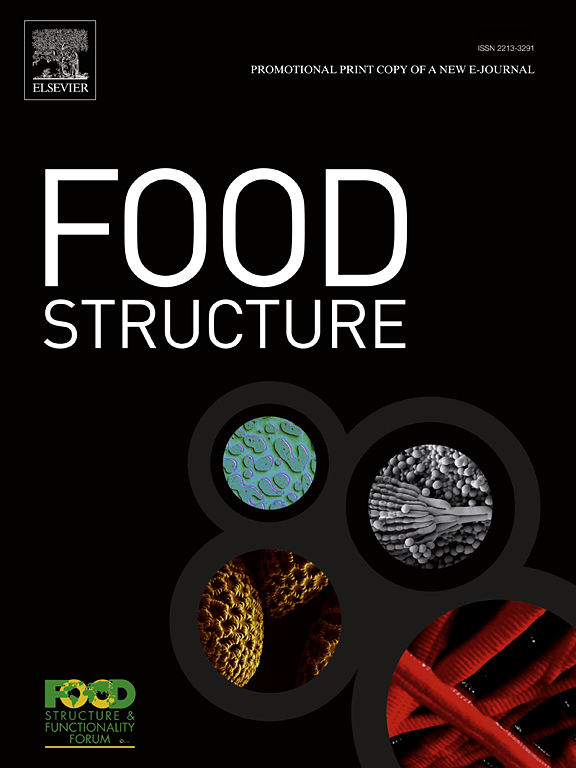高压微流化法修饰大麻籽粕蛋白的理化、结构和功能特性
IF 5.9
3区 农林科学
Q1 FOOD SCIENCE & TECHNOLOGY
引用次数: 0
摘要
该研究探讨了不同压力(25、75、100和125 MPa;单次)下高压微流化(HPM)对大麻籽粕蛋白物理功能特性的影响。在100 MPa时,平均粒径降幅最大(53.57 %)。SDS-PAGE分析显示,条带强度随压力的增加而减小。圆二色性(CD)光谱显示了α-螺旋向β-片的转变,以及随着施加压力的增加,平行β-片向混合β-片的转变。紫外可见光谱和本征荧光光谱证实了大麻蛋白的三级结构重排。在100 MPa下,蛋白质消化率提高24.74 %,体外PDCAAS提高23.47 %。观察到大麻蛋白功能的显著改善(P <; 0.05),即自由基清除活性,蛋白质溶解度和乳化性能。这些增强在100 MPa压力下更为突出,证实了其正调节大麻蛋白功能属性的有效性。这些结果将有助于扩大其潜在的食品应用。本文章由计算机程序翻译,如有差异,请以英文原文为准。
Modification of physico-chemical, structural and functional properties of hemp seed meal proteins by high-pressure microfluidisation
The study explored the effect of high-pressure microfluidisation (HPM) at varying pressures (25, 75, 100, and 125 MPa; single pass) on physico-functional properties of hemp seed meal proteins. The highest reduction (53.57 %) in the mean particle size was observed at 100 MPa. SDS-PAGE showed that the intensity of bands decreased with increasing pressure. Circular Dichroism (CD) spectra reveal an α-helix to β-sheet transition, along with the conversion of β-parallel to mixed β-sheets with enhancement in the applied pressure. UV-Vis and intrinsic fluorescence spectroscopy confirmed tertiary structural rearrangements in hemp proteins. A 24.74 % increment in protein digestibility and 23.47 % enhancement in in vitro PDCAAS was observed for the sample treated at 100 MPa. A significant (P < 0.05) improvement in hemp protein functionalities was observed, viz., free radical scavenging activity, protein solubility, and emulsifying properties. These enhancements were more prominent at 100 MPa pressure, confirming its effectiveness in positively modulating the functional attributes of hemp proteins. These results shall help augmenting their potential food applications.
求助全文
通过发布文献求助,成功后即可免费获取论文全文。
去求助
来源期刊

Food Structure-Netherlands
Chemical Engineering-Bioengineering
CiteScore
7.20
自引率
0.00%
发文量
48
期刊介绍:
Food Structure is the premier international forum devoted to the publication of high-quality original research on food structure. The focus of this journal is on food structure in the context of its relationship with molecular composition, processing and macroscopic properties (e.g., shelf stability, sensory properties, etc.). Manuscripts that only report qualitative findings and micrographs and that lack sound hypothesis-driven, quantitative structure-function research are not accepted. Significance of the research findings for the food science community and/or industry must also be highlighted.
 求助内容:
求助内容: 应助结果提醒方式:
应助结果提醒方式:


